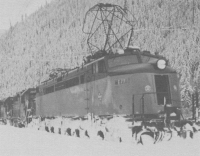|
At the same time the five bi-polars were
ordered for use in the Cascades, ten passenger locomotives for use in
Montana and Idaho were ordered from Westinghouse and Baldwin Locomotive
Works, the only electric locomotives not purchased
from the Alco-GE combination. The railroad split its order between Alco-GE
and Westinghouse-Baldwin for faster delivery, since the rapidly rising
cost of fuel oil used for steam engines then in service was a severe
financial drain.
Built for the same high-speed,
heavy-duty passenger service as the bi-polars, the EP-3s, as they were
designated, had a much more conventional box-cab design.
Although they performed well, the EP-3
locomotives were scrapped shortly after the Korean War due to high
maintenance costs and a general decline in passenger traffic.
The present mainstays of the Milwaukee
Road’s electric power fleet are the “Little Joes,” the EF-4 locomotives.

These Alco-GE units, dubbed “Little
Joes” after Josef Stalin because they were originally built for use in the
Soviet Union, were acquired in 1950.
With the advent of the Cold War,
essential equipment going to Russia was embargoed and the locomotives,
ordered by the U.S.S.R., were never delivered. Twelve of the units were
purchased by the Milwaukee Road, with others going to the Chicago South
Shore and South Bend Railroad and the Paulista Railroad of Brazil.
Built for the Russian 5’ gauge track,
the “Little Joes” were modified for standard American 4’-8½” gauge at the
railroad’s Milwaukee Shops and put into service. Train heating boilers
(since removed) were also added to two of the units for passenger service.
Purchased at very favorable prices, the
powerful EF-4s have proved highly versatile and reliable.
Each unit develops 5500 h.p. and is
capable of running at 70 m.p.h., making them valuable additions to the
motive power fleet. But now even the “Little Joes” are nearing the end of
their life expectancy.
The fortuitous availability of these
units in 1950 may have single-handedly extended the life of the
electrification. At that time the original electric locomotives were
rapidly wearing out and a policy decision seemed in the offing on whether
to invest heavily in new electric units or to broaden the dieselization
program to include phasing out the electrics as well as steam locomotives.
But the decision never had to be made. |
